MAN508 Organisational Strategy: Retail Industry in Australia
VerifiedAdded on 2023/06/13
|19
|5693
|78
Report
AI Summary
This report provides a strategic analysis of the Australian retail industry using Porter’s Five Forces model, examining the threats of substitutes and new entrants, rivalry, and the bargaining power of suppliers and buyers. It discusses the profitability and future growth potential of the Australian retail sector, highlighting the increasing role of online activities. The analysis indicates that the Australian retail sector possesses significant growth opportunities despite challenges like its isolated geography. The report also notes the increasing presence of international retailers and the competitive responses of local Australian companies. Desklib provides students access to this and many other solved assignments.
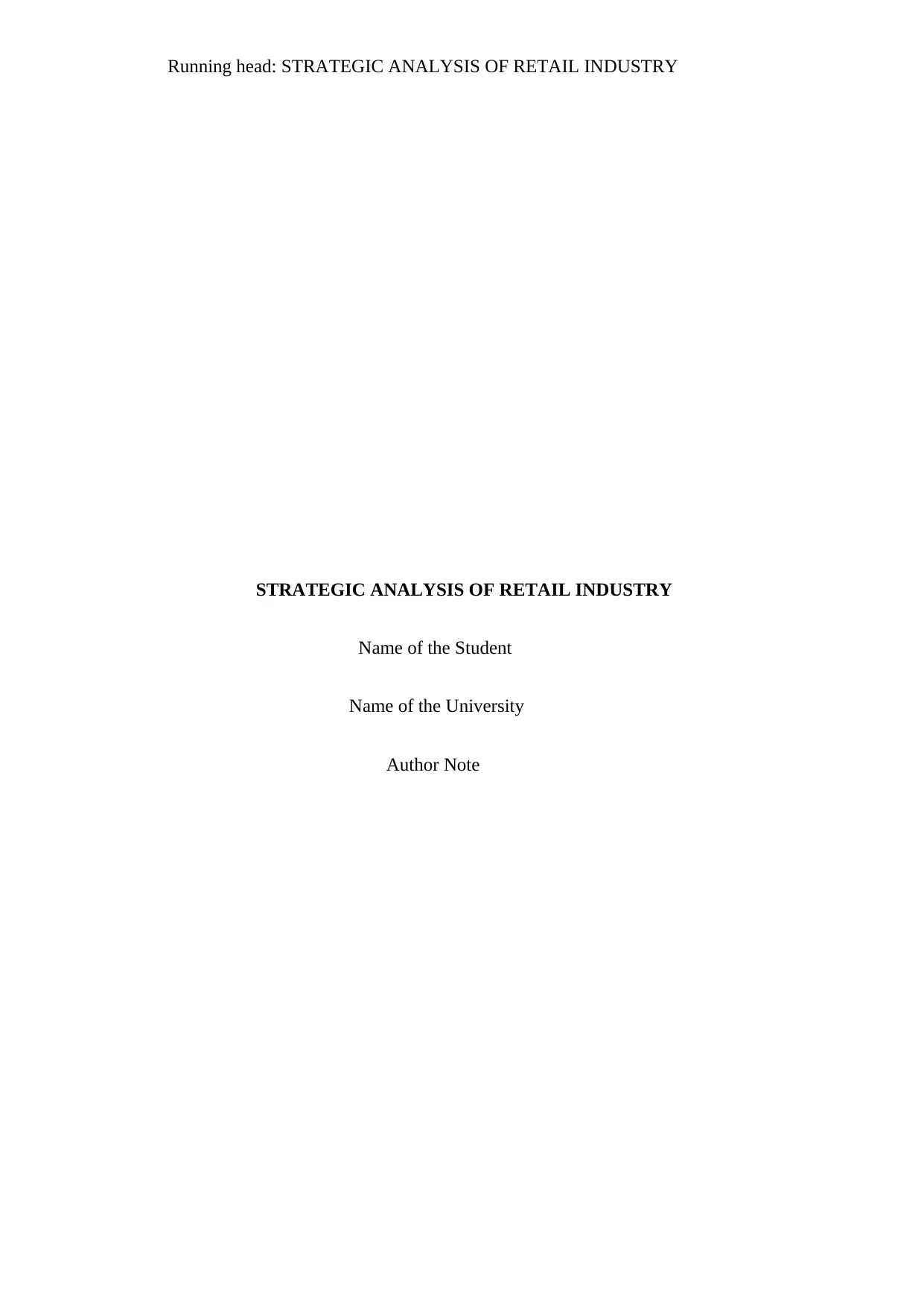
Running head: STRATEGIC ANALYSIS OF RETAIL INDUSTRY
STRATEGIC ANALYSIS OF RETAIL INDUSTRY
Name of the Student
Name of the University
Author Note
STRATEGIC ANALYSIS OF RETAIL INDUSTRY
Name of the Student
Name of the University
Author Note
Paraphrase This Document
Need a fresh take? Get an instant paraphrase of this document with our AI Paraphraser
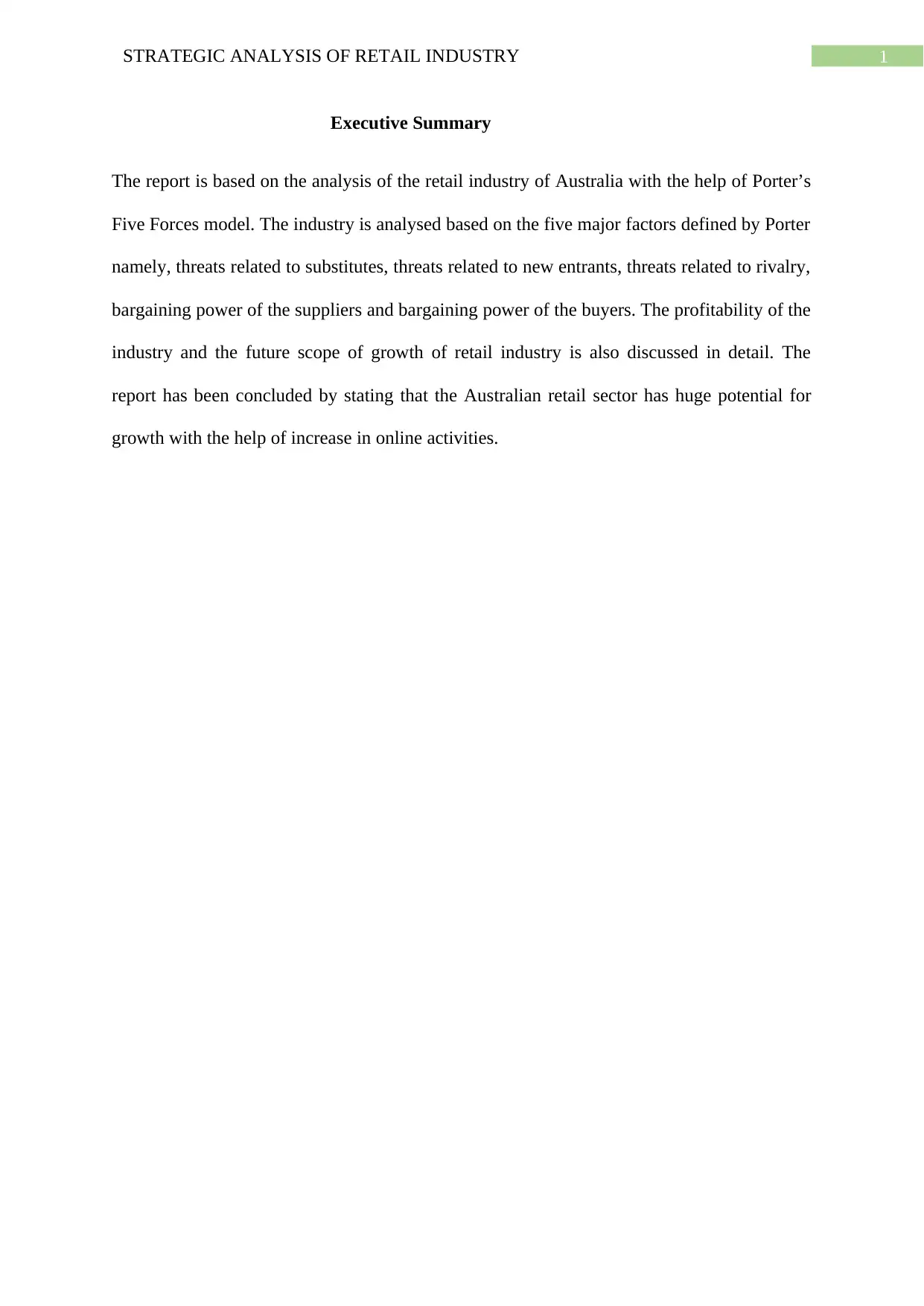
1STRATEGIC ANALYSIS OF RETAIL INDUSTRY
Executive Summary
The report is based on the analysis of the retail industry of Australia with the help of Porter’s
Five Forces model. The industry is analysed based on the five major factors defined by Porter
namely, threats related to substitutes, threats related to new entrants, threats related to rivalry,
bargaining power of the suppliers and bargaining power of the buyers. The profitability of the
industry and the future scope of growth of retail industry is also discussed in detail. The
report has been concluded by stating that the Australian retail sector has huge potential for
growth with the help of increase in online activities.
Executive Summary
The report is based on the analysis of the retail industry of Australia with the help of Porter’s
Five Forces model. The industry is analysed based on the five major factors defined by Porter
namely, threats related to substitutes, threats related to new entrants, threats related to rivalry,
bargaining power of the suppliers and bargaining power of the buyers. The profitability of the
industry and the future scope of growth of retail industry is also discussed in detail. The
report has been concluded by stating that the Australian retail sector has huge potential for
growth with the help of increase in online activities.
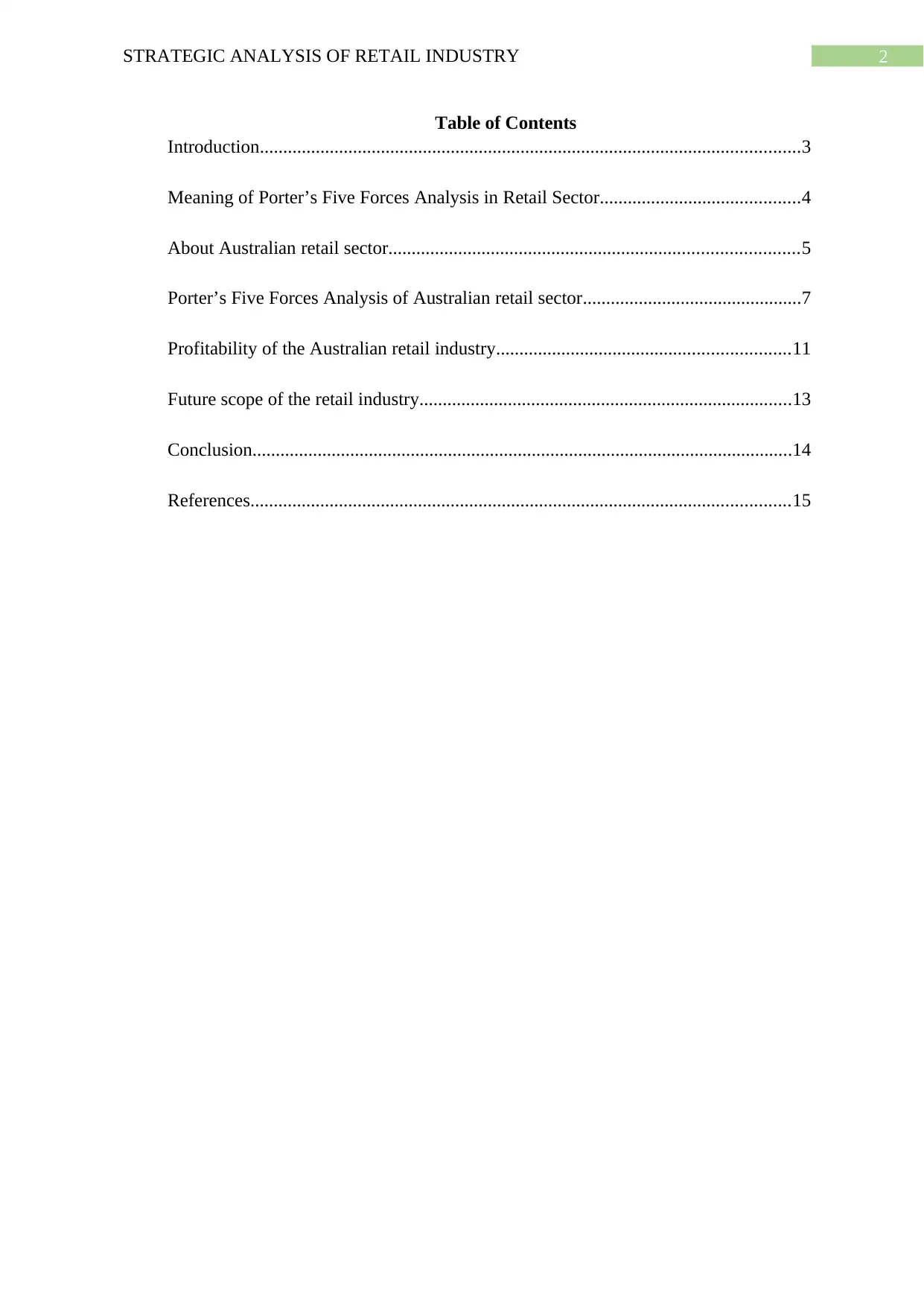
2STRATEGIC ANALYSIS OF RETAIL INDUSTRY
Table of Contents
Introduction....................................................................................................................3
Meaning of Porter’s Five Forces Analysis in Retail Sector...........................................4
About Australian retail sector........................................................................................5
Porter’s Five Forces Analysis of Australian retail sector...............................................7
Profitability of the Australian retail industry...............................................................11
Future scope of the retail industry................................................................................13
Conclusion....................................................................................................................14
References....................................................................................................................15
Table of Contents
Introduction....................................................................................................................3
Meaning of Porter’s Five Forces Analysis in Retail Sector...........................................4
About Australian retail sector........................................................................................5
Porter’s Five Forces Analysis of Australian retail sector...............................................7
Profitability of the Australian retail industry...............................................................11
Future scope of the retail industry................................................................................13
Conclusion....................................................................................................................14
References....................................................................................................................15
⊘ This is a preview!⊘
Do you want full access?
Subscribe today to unlock all pages.

Trusted by 1+ million students worldwide
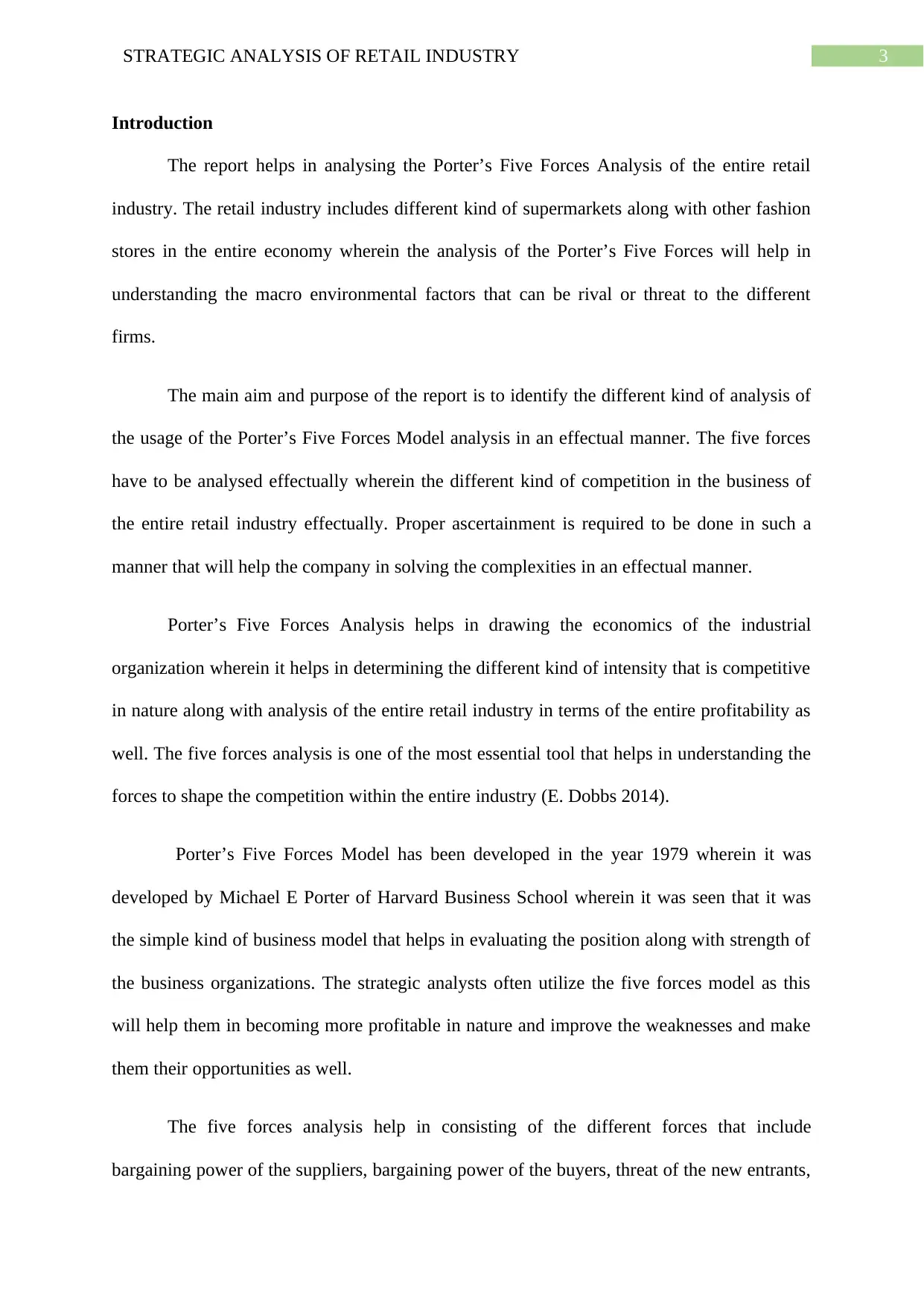
3STRATEGIC ANALYSIS OF RETAIL INDUSTRY
Introduction
The report helps in analysing the Porter’s Five Forces Analysis of the entire retail
industry. The retail industry includes different kind of supermarkets along with other fashion
stores in the entire economy wherein the analysis of the Porter’s Five Forces will help in
understanding the macro environmental factors that can be rival or threat to the different
firms.
The main aim and purpose of the report is to identify the different kind of analysis of
the usage of the Porter’s Five Forces Model analysis in an effectual manner. The five forces
have to be analysed effectually wherein the different kind of competition in the business of
the entire retail industry effectually. Proper ascertainment is required to be done in such a
manner that will help the company in solving the complexities in an effectual manner.
Porter’s Five Forces Analysis helps in drawing the economics of the industrial
organization wherein it helps in determining the different kind of intensity that is competitive
in nature along with analysis of the entire retail industry in terms of the entire profitability as
well. The five forces analysis is one of the most essential tool that helps in understanding the
forces to shape the competition within the entire industry (E. Dobbs 2014).
Porter’s Five Forces Model has been developed in the year 1979 wherein it was
developed by Michael E Porter of Harvard Business School wherein it was seen that it was
the simple kind of business model that helps in evaluating the position along with strength of
the business organizations. The strategic analysts often utilize the five forces model as this
will help them in becoming more profitable in nature and improve the weaknesses and make
them their opportunities as well.
The five forces analysis help in consisting of the different forces that include
bargaining power of the suppliers, bargaining power of the buyers, threat of the new entrants,
Introduction
The report helps in analysing the Porter’s Five Forces Analysis of the entire retail
industry. The retail industry includes different kind of supermarkets along with other fashion
stores in the entire economy wherein the analysis of the Porter’s Five Forces will help in
understanding the macro environmental factors that can be rival or threat to the different
firms.
The main aim and purpose of the report is to identify the different kind of analysis of
the usage of the Porter’s Five Forces Model analysis in an effectual manner. The five forces
have to be analysed effectually wherein the different kind of competition in the business of
the entire retail industry effectually. Proper ascertainment is required to be done in such a
manner that will help the company in solving the complexities in an effectual manner.
Porter’s Five Forces Analysis helps in drawing the economics of the industrial
organization wherein it helps in determining the different kind of intensity that is competitive
in nature along with analysis of the entire retail industry in terms of the entire profitability as
well. The five forces analysis is one of the most essential tool that helps in understanding the
forces to shape the competition within the entire industry (E. Dobbs 2014).
Porter’s Five Forces Model has been developed in the year 1979 wherein it was
developed by Michael E Porter of Harvard Business School wherein it was seen that it was
the simple kind of business model that helps in evaluating the position along with strength of
the business organizations. The strategic analysts often utilize the five forces model as this
will help them in becoming more profitable in nature and improve the weaknesses and make
them their opportunities as well.
The five forces analysis help in consisting of the different forces that include
bargaining power of the suppliers, bargaining power of the buyers, threat of the new entrants,
Paraphrase This Document
Need a fresh take? Get an instant paraphrase of this document with our AI Paraphraser
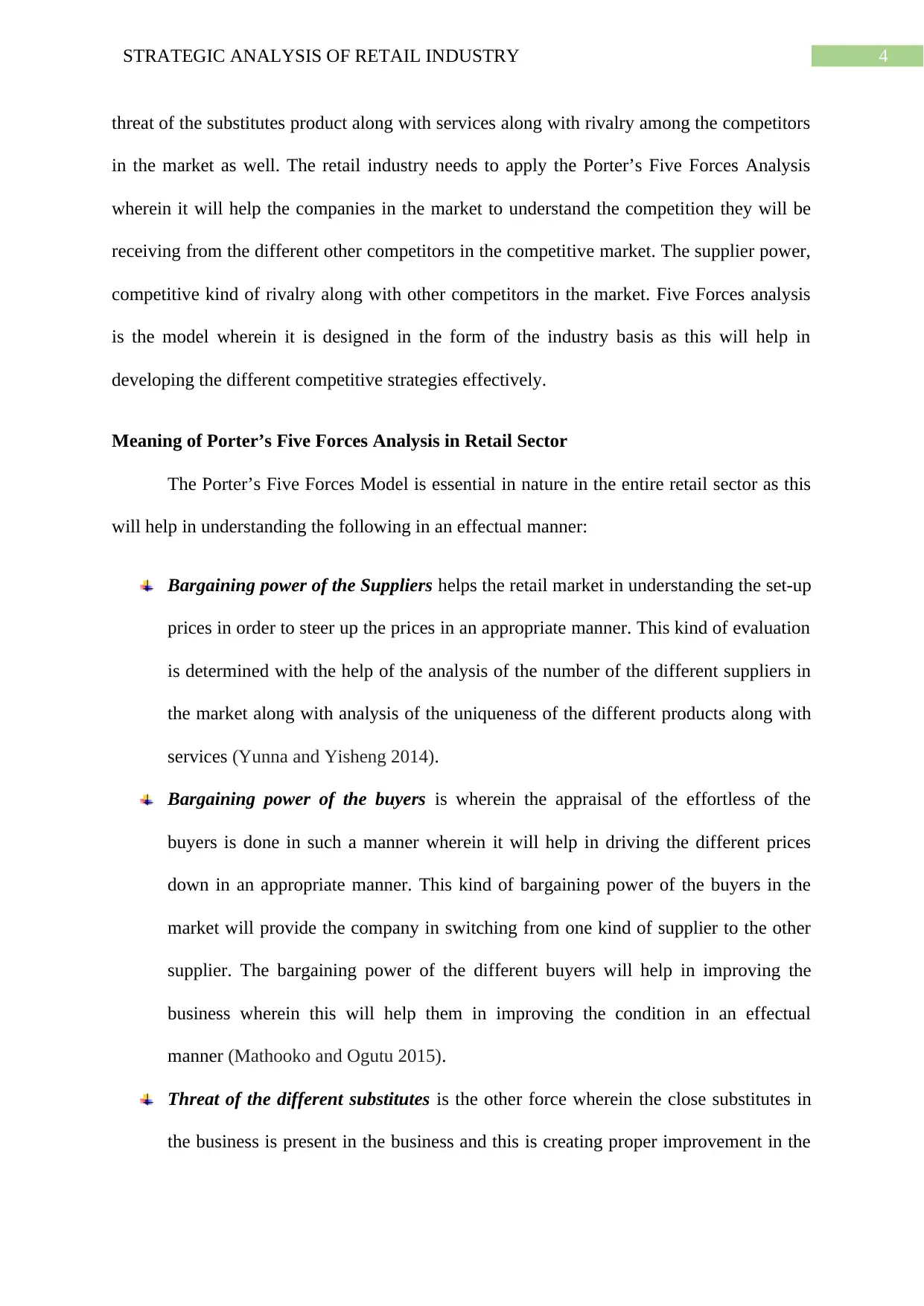
4STRATEGIC ANALYSIS OF RETAIL INDUSTRY
threat of the substitutes product along with services along with rivalry among the competitors
in the market as well. The retail industry needs to apply the Porter’s Five Forces Analysis
wherein it will help the companies in the market to understand the competition they will be
receiving from the different other competitors in the competitive market. The supplier power,
competitive kind of rivalry along with other competitors in the market. Five Forces analysis
is the model wherein it is designed in the form of the industry basis as this will help in
developing the different competitive strategies effectively.
Meaning of Porter’s Five Forces Analysis in Retail Sector
The Porter’s Five Forces Model is essential in nature in the entire retail sector as this
will help in understanding the following in an effectual manner:
Bargaining power of the Suppliers helps the retail market in understanding the set-up
prices in order to steer up the prices in an appropriate manner. This kind of evaluation
is determined with the help of the analysis of the number of the different suppliers in
the market along with analysis of the uniqueness of the different products along with
services (Yunna and Yisheng 2014).
Bargaining power of the buyers is wherein the appraisal of the effortless of the
buyers is done in such a manner wherein it will help in driving the different prices
down in an appropriate manner. This kind of bargaining power of the buyers in the
market will provide the company in switching from one kind of supplier to the other
supplier. The bargaining power of the different buyers will help in improving the
business wherein this will help them in improving the condition in an effectual
manner (Mathooko and Ogutu 2015).
Threat of the different substitutes is the other force wherein the close substitutes in
the business is present in the business and this is creating proper improvement in the
threat of the substitutes product along with services along with rivalry among the competitors
in the market as well. The retail industry needs to apply the Porter’s Five Forces Analysis
wherein it will help the companies in the market to understand the competition they will be
receiving from the different other competitors in the competitive market. The supplier power,
competitive kind of rivalry along with other competitors in the market. Five Forces analysis
is the model wherein it is designed in the form of the industry basis as this will help in
developing the different competitive strategies effectively.
Meaning of Porter’s Five Forces Analysis in Retail Sector
The Porter’s Five Forces Model is essential in nature in the entire retail sector as this
will help in understanding the following in an effectual manner:
Bargaining power of the Suppliers helps the retail market in understanding the set-up
prices in order to steer up the prices in an appropriate manner. This kind of evaluation
is determined with the help of the analysis of the number of the different suppliers in
the market along with analysis of the uniqueness of the different products along with
services (Yunna and Yisheng 2014).
Bargaining power of the buyers is wherein the appraisal of the effortless of the
buyers is done in such a manner wherein it will help in driving the different prices
down in an appropriate manner. This kind of bargaining power of the buyers in the
market will provide the company in switching from one kind of supplier to the other
supplier. The bargaining power of the different buyers will help in improving the
business wherein this will help them in improving the condition in an effectual
manner (Mathooko and Ogutu 2015).
Threat of the different substitutes is the other force wherein the close substitutes in
the business is present in the business and this is creating proper improvement in the
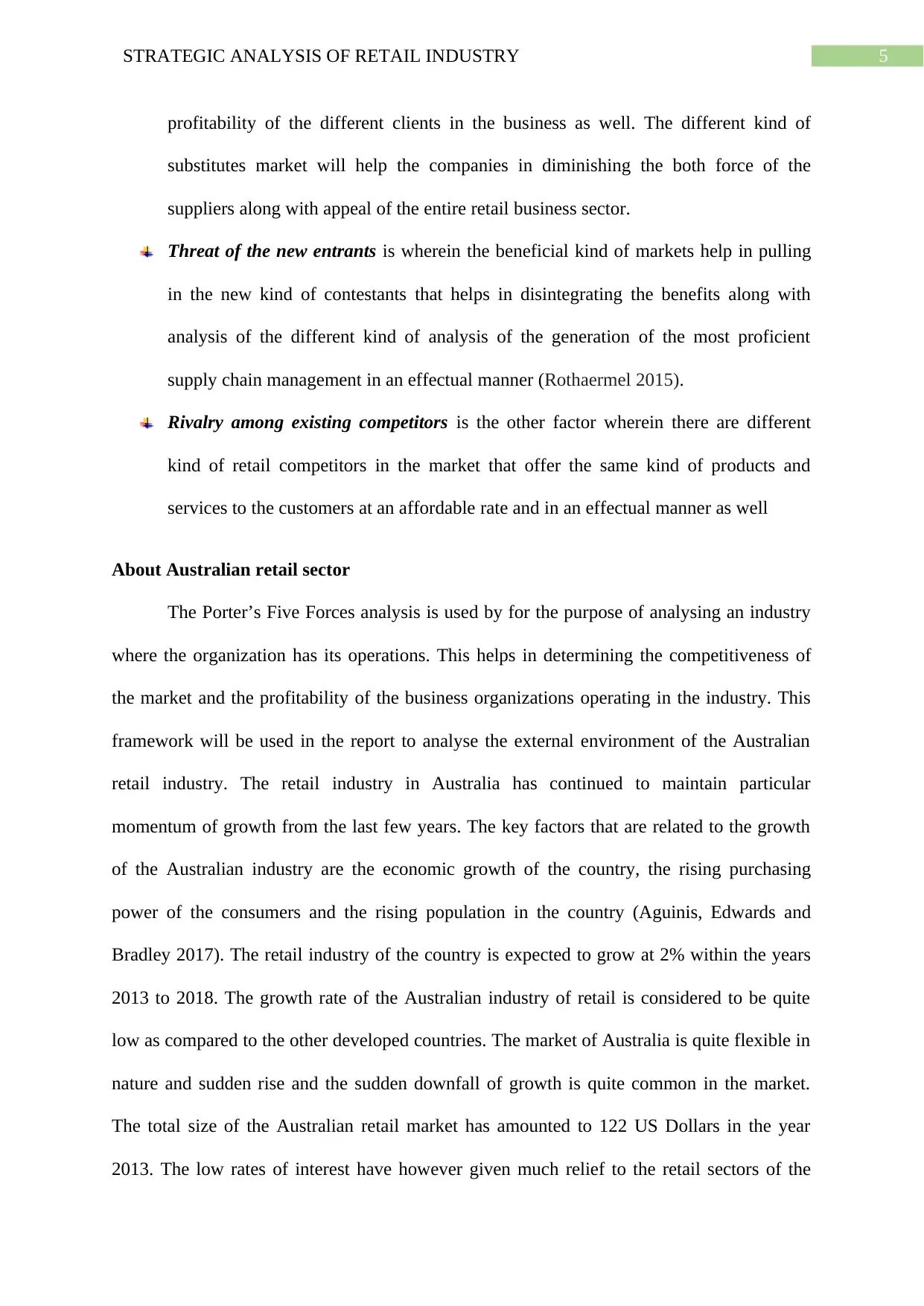
5STRATEGIC ANALYSIS OF RETAIL INDUSTRY
profitability of the different clients in the business as well. The different kind of
substitutes market will help the companies in diminishing the both force of the
suppliers along with appeal of the entire retail business sector.
Threat of the new entrants is wherein the beneficial kind of markets help in pulling
in the new kind of contestants that helps in disintegrating the benefits along with
analysis of the different kind of analysis of the generation of the most proficient
supply chain management in an effectual manner (Rothaermel 2015).
Rivalry among existing competitors is the other factor wherein there are different
kind of retail competitors in the market that offer the same kind of products and
services to the customers at an affordable rate and in an effectual manner as well
About Australian retail sector
The Porter’s Five Forces analysis is used by for the purpose of analysing an industry
where the organization has its operations. This helps in determining the competitiveness of
the market and the profitability of the business organizations operating in the industry. This
framework will be used in the report to analyse the external environment of the Australian
retail industry. The retail industry in Australia has continued to maintain particular
momentum of growth from the last few years. The key factors that are related to the growth
of the Australian industry are the economic growth of the country, the rising purchasing
power of the consumers and the rising population in the country (Aguinis, Edwards and
Bradley 2017). The retail industry of the country is expected to grow at 2% within the years
2013 to 2018. The growth rate of the Australian industry of retail is considered to be quite
low as compared to the other developed countries. The market of Australia is quite flexible in
nature and sudden rise and the sudden downfall of growth is quite common in the market.
The total size of the Australian retail market has amounted to 122 US Dollars in the year
2013. The low rates of interest have however given much relief to the retail sectors of the
profitability of the different clients in the business as well. The different kind of
substitutes market will help the companies in diminishing the both force of the
suppliers along with appeal of the entire retail business sector.
Threat of the new entrants is wherein the beneficial kind of markets help in pulling
in the new kind of contestants that helps in disintegrating the benefits along with
analysis of the different kind of analysis of the generation of the most proficient
supply chain management in an effectual manner (Rothaermel 2015).
Rivalry among existing competitors is the other factor wherein there are different
kind of retail competitors in the market that offer the same kind of products and
services to the customers at an affordable rate and in an effectual manner as well
About Australian retail sector
The Porter’s Five Forces analysis is used by for the purpose of analysing an industry
where the organization has its operations. This helps in determining the competitiveness of
the market and the profitability of the business organizations operating in the industry. This
framework will be used in the report to analyse the external environment of the Australian
retail industry. The retail industry in Australia has continued to maintain particular
momentum of growth from the last few years. The key factors that are related to the growth
of the Australian industry are the economic growth of the country, the rising purchasing
power of the consumers and the rising population in the country (Aguinis, Edwards and
Bradley 2017). The retail industry of the country is expected to grow at 2% within the years
2013 to 2018. The growth rate of the Australian industry of retail is considered to be quite
low as compared to the other developed countries. The market of Australia is quite flexible in
nature and sudden rise and the sudden downfall of growth is quite common in the market.
The total size of the Australian retail market has amounted to 122 US Dollars in the year
2013. The low rates of interest have however given much relief to the retail sectors of the
⊘ This is a preview!⊘
Do you want full access?
Subscribe today to unlock all pages.

Trusted by 1+ million students worldwide
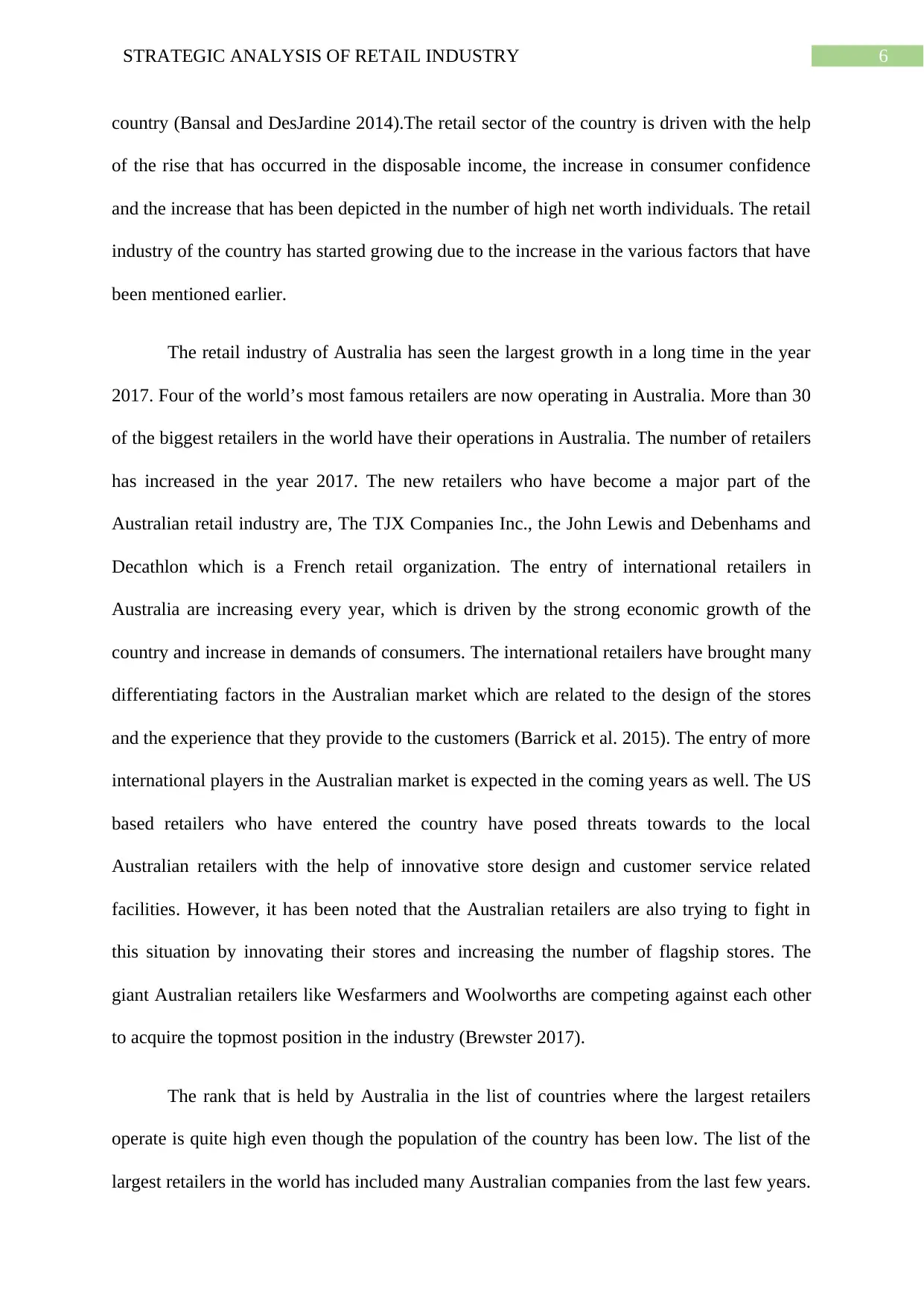
6STRATEGIC ANALYSIS OF RETAIL INDUSTRY
country (Bansal and DesJardine 2014).The retail sector of the country is driven with the help
of the rise that has occurred in the disposable income, the increase in consumer confidence
and the increase that has been depicted in the number of high net worth individuals. The retail
industry of the country has started growing due to the increase in the various factors that have
been mentioned earlier.
The retail industry of Australia has seen the largest growth in a long time in the year
2017. Four of the world’s most famous retailers are now operating in Australia. More than 30
of the biggest retailers in the world have their operations in Australia. The number of retailers
has increased in the year 2017. The new retailers who have become a major part of the
Australian retail industry are, The TJX Companies Inc., the John Lewis and Debenhams and
Decathlon which is a French retail organization. The entry of international retailers in
Australia are increasing every year, which is driven by the strong economic growth of the
country and increase in demands of consumers. The international retailers have brought many
differentiating factors in the Australian market which are related to the design of the stores
and the experience that they provide to the customers (Barrick et al. 2015). The entry of more
international players in the Australian market is expected in the coming years as well. The US
based retailers who have entered the country have posed threats towards to the local
Australian retailers with the help of innovative store design and customer service related
facilities. However, it has been noted that the Australian retailers are also trying to fight in
this situation by innovating their stores and increasing the number of flagship stores. The
giant Australian retailers like Wesfarmers and Woolworths are competing against each other
to acquire the topmost position in the industry (Brewster 2017).
The rank that is held by Australia in the list of countries where the largest retailers
operate is quite high even though the population of the country has been low. The list of the
largest retailers in the world has included many Australian companies from the last few years.
country (Bansal and DesJardine 2014).The retail sector of the country is driven with the help
of the rise that has occurred in the disposable income, the increase in consumer confidence
and the increase that has been depicted in the number of high net worth individuals. The retail
industry of the country has started growing due to the increase in the various factors that have
been mentioned earlier.
The retail industry of Australia has seen the largest growth in a long time in the year
2017. Four of the world’s most famous retailers are now operating in Australia. More than 30
of the biggest retailers in the world have their operations in Australia. The number of retailers
has increased in the year 2017. The new retailers who have become a major part of the
Australian retail industry are, The TJX Companies Inc., the John Lewis and Debenhams and
Decathlon which is a French retail organization. The entry of international retailers in
Australia are increasing every year, which is driven by the strong economic growth of the
country and increase in demands of consumers. The international retailers have brought many
differentiating factors in the Australian market which are related to the design of the stores
and the experience that they provide to the customers (Barrick et al. 2015). The entry of more
international players in the Australian market is expected in the coming years as well. The US
based retailers who have entered the country have posed threats towards to the local
Australian retailers with the help of innovative store design and customer service related
facilities. However, it has been noted that the Australian retailers are also trying to fight in
this situation by innovating their stores and increasing the number of flagship stores. The
giant Australian retailers like Wesfarmers and Woolworths are competing against each other
to acquire the topmost position in the industry (Brewster 2017).
The rank that is held by Australia in the list of countries where the largest retailers
operate is quite high even though the population of the country has been low. The list of the
largest retailers in the world has included many Australian companies from the last few years.
Paraphrase This Document
Need a fresh take? Get an instant paraphrase of this document with our AI Paraphraser
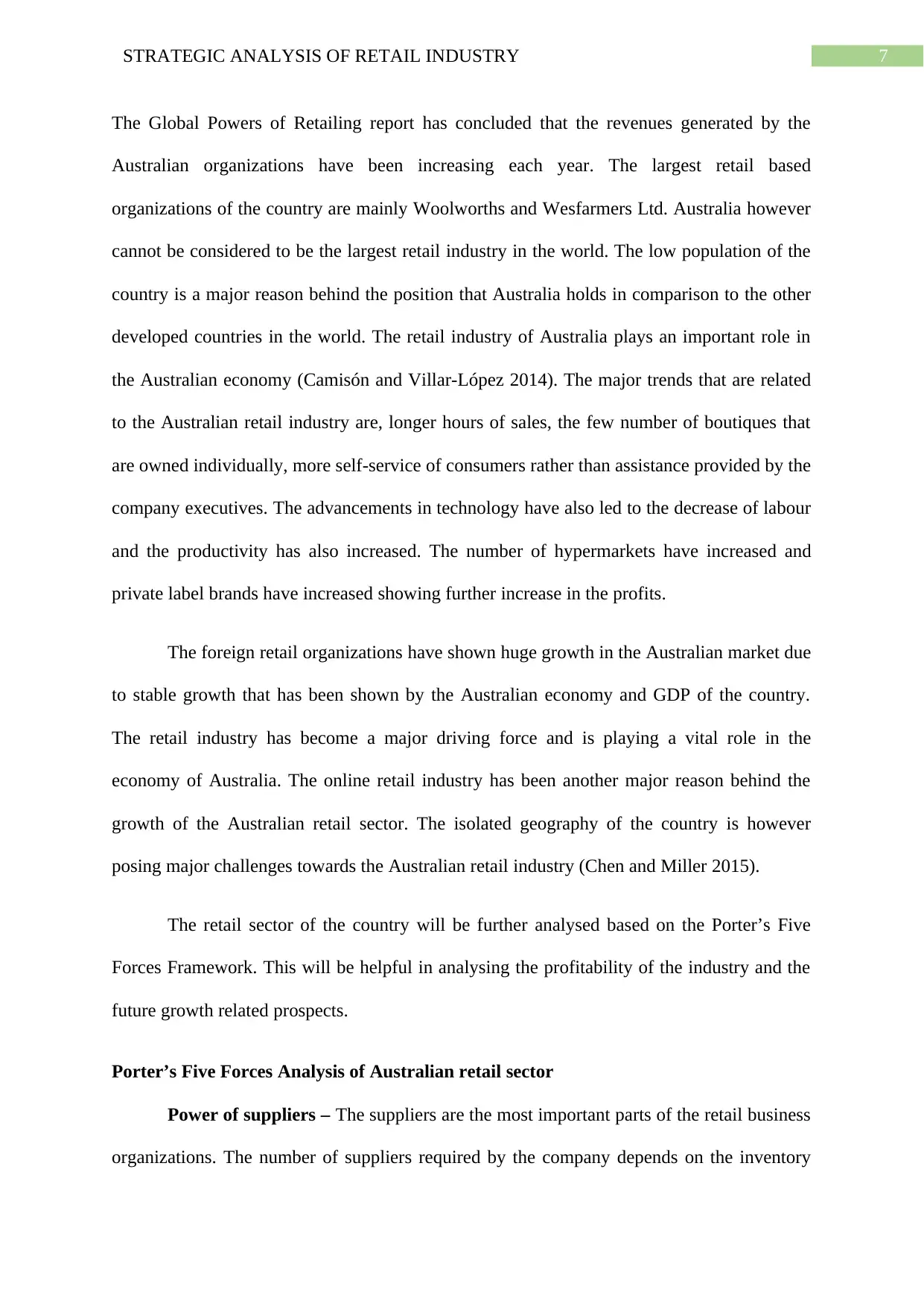
7STRATEGIC ANALYSIS OF RETAIL INDUSTRY
The Global Powers of Retailing report has concluded that the revenues generated by the
Australian organizations have been increasing each year. The largest retail based
organizations of the country are mainly Woolworths and Wesfarmers Ltd. Australia however
cannot be considered to be the largest retail industry in the world. The low population of the
country is a major reason behind the position that Australia holds in comparison to the other
developed countries in the world. The retail industry of Australia plays an important role in
the Australian economy (Camisón and Villar-López 2014). The major trends that are related
to the Australian retail industry are, longer hours of sales, the few number of boutiques that
are owned individually, more self-service of consumers rather than assistance provided by the
company executives. The advancements in technology have also led to the decrease of labour
and the productivity has also increased. The number of hypermarkets have increased and
private label brands have increased showing further increase in the profits.
The foreign retail organizations have shown huge growth in the Australian market due
to stable growth that has been shown by the Australian economy and GDP of the country.
The retail industry has become a major driving force and is playing a vital role in the
economy of Australia. The online retail industry has been another major reason behind the
growth of the Australian retail sector. The isolated geography of the country is however
posing major challenges towards the Australian retail industry (Chen and Miller 2015).
The retail sector of the country will be further analysed based on the Porter’s Five
Forces Framework. This will be helpful in analysing the profitability of the industry and the
future growth related prospects.
Porter’s Five Forces Analysis of Australian retail sector
Power of suppliers – The suppliers are the most important parts of the retail business
organizations. The number of suppliers required by the company depends on the inventory
The Global Powers of Retailing report has concluded that the revenues generated by the
Australian organizations have been increasing each year. The largest retail based
organizations of the country are mainly Woolworths and Wesfarmers Ltd. Australia however
cannot be considered to be the largest retail industry in the world. The low population of the
country is a major reason behind the position that Australia holds in comparison to the other
developed countries in the world. The retail industry of Australia plays an important role in
the Australian economy (Camisón and Villar-López 2014). The major trends that are related
to the Australian retail industry are, longer hours of sales, the few number of boutiques that
are owned individually, more self-service of consumers rather than assistance provided by the
company executives. The advancements in technology have also led to the decrease of labour
and the productivity has also increased. The number of hypermarkets have increased and
private label brands have increased showing further increase in the profits.
The foreign retail organizations have shown huge growth in the Australian market due
to stable growth that has been shown by the Australian economy and GDP of the country.
The retail industry has become a major driving force and is playing a vital role in the
economy of Australia. The online retail industry has been another major reason behind the
growth of the Australian retail sector. The isolated geography of the country is however
posing major challenges towards the Australian retail industry (Chen and Miller 2015).
The retail sector of the country will be further analysed based on the Porter’s Five
Forces Framework. This will be helpful in analysing the profitability of the industry and the
future growth related prospects.
Porter’s Five Forces Analysis of Australian retail sector
Power of suppliers – The suppliers are the most important parts of the retail business
organizations. The number of suppliers required by the company depends on the inventory
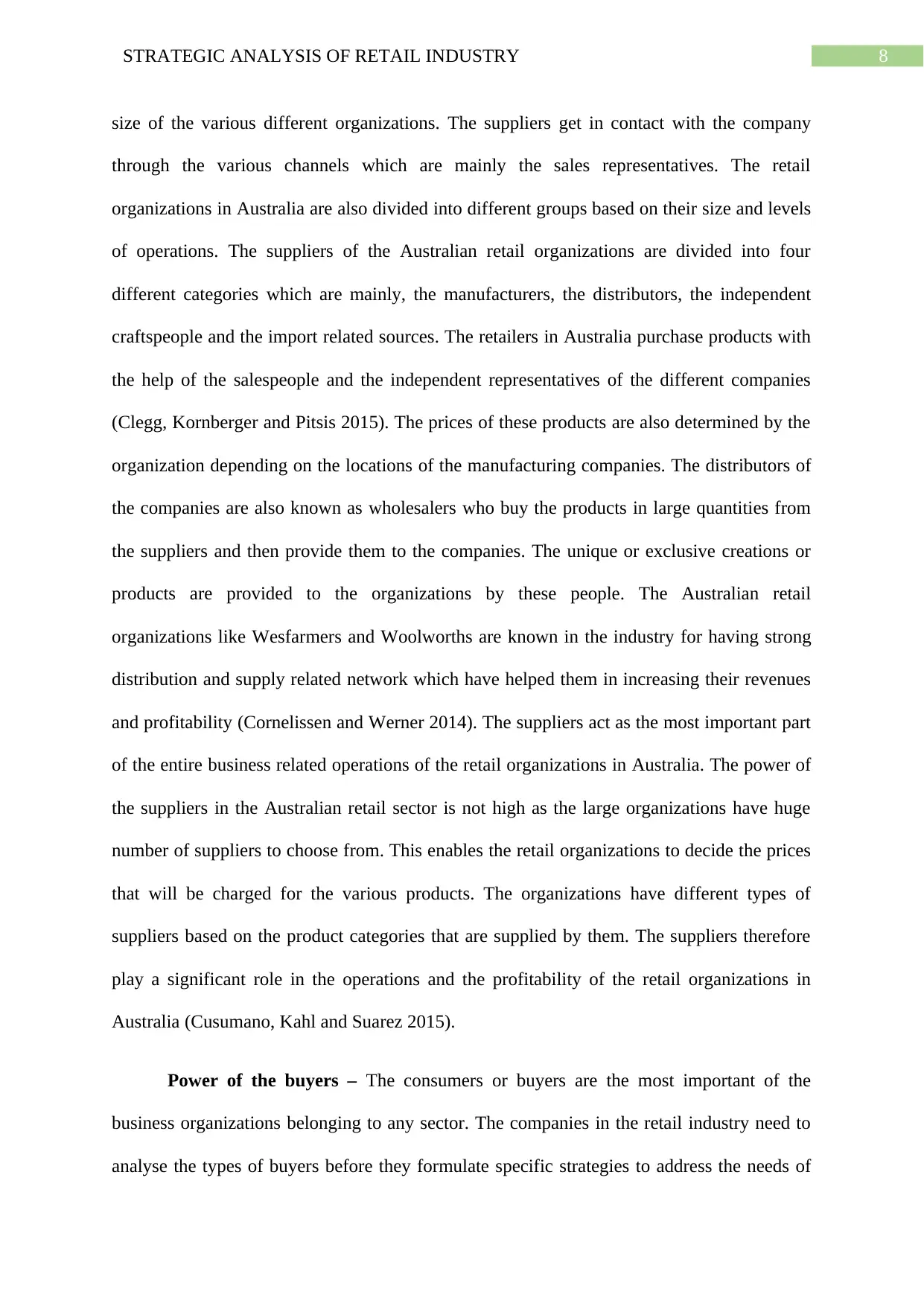
8STRATEGIC ANALYSIS OF RETAIL INDUSTRY
size of the various different organizations. The suppliers get in contact with the company
through the various channels which are mainly the sales representatives. The retail
organizations in Australia are also divided into different groups based on their size and levels
of operations. The suppliers of the Australian retail organizations are divided into four
different categories which are mainly, the manufacturers, the distributors, the independent
craftspeople and the import related sources. The retailers in Australia purchase products with
the help of the salespeople and the independent representatives of the different companies
(Clegg, Kornberger and Pitsis 2015). The prices of these products are also determined by the
organization depending on the locations of the manufacturing companies. The distributors of
the companies are also known as wholesalers who buy the products in large quantities from
the suppliers and then provide them to the companies. The unique or exclusive creations or
products are provided to the organizations by these people. The Australian retail
organizations like Wesfarmers and Woolworths are known in the industry for having strong
distribution and supply related network which have helped them in increasing their revenues
and profitability (Cornelissen and Werner 2014). The suppliers act as the most important part
of the entire business related operations of the retail organizations in Australia. The power of
the suppliers in the Australian retail sector is not high as the large organizations have huge
number of suppliers to choose from. This enables the retail organizations to decide the prices
that will be charged for the various products. The organizations have different types of
suppliers based on the product categories that are supplied by them. The suppliers therefore
play a significant role in the operations and the profitability of the retail organizations in
Australia (Cusumano, Kahl and Suarez 2015).
Power of the buyers – The consumers or buyers are the most important of the
business organizations belonging to any sector. The companies in the retail industry need to
analyse the types of buyers before they formulate specific strategies to address the needs of
size of the various different organizations. The suppliers get in contact with the company
through the various channels which are mainly the sales representatives. The retail
organizations in Australia are also divided into different groups based on their size and levels
of operations. The suppliers of the Australian retail organizations are divided into four
different categories which are mainly, the manufacturers, the distributors, the independent
craftspeople and the import related sources. The retailers in Australia purchase products with
the help of the salespeople and the independent representatives of the different companies
(Clegg, Kornberger and Pitsis 2015). The prices of these products are also determined by the
organization depending on the locations of the manufacturing companies. The distributors of
the companies are also known as wholesalers who buy the products in large quantities from
the suppliers and then provide them to the companies. The unique or exclusive creations or
products are provided to the organizations by these people. The Australian retail
organizations like Wesfarmers and Woolworths are known in the industry for having strong
distribution and supply related network which have helped them in increasing their revenues
and profitability (Cornelissen and Werner 2014). The suppliers act as the most important part
of the entire business related operations of the retail organizations in Australia. The power of
the suppliers in the Australian retail sector is not high as the large organizations have huge
number of suppliers to choose from. This enables the retail organizations to decide the prices
that will be charged for the various products. The organizations have different types of
suppliers based on the product categories that are supplied by them. The suppliers therefore
play a significant role in the operations and the profitability of the retail organizations in
Australia (Cusumano, Kahl and Suarez 2015).
Power of the buyers – The consumers or buyers are the most important of the
business organizations belonging to any sector. The companies in the retail industry need to
analyse the types of buyers before they formulate specific strategies to address the needs of
⊘ This is a preview!⊘
Do you want full access?
Subscribe today to unlock all pages.

Trusted by 1+ million students worldwide
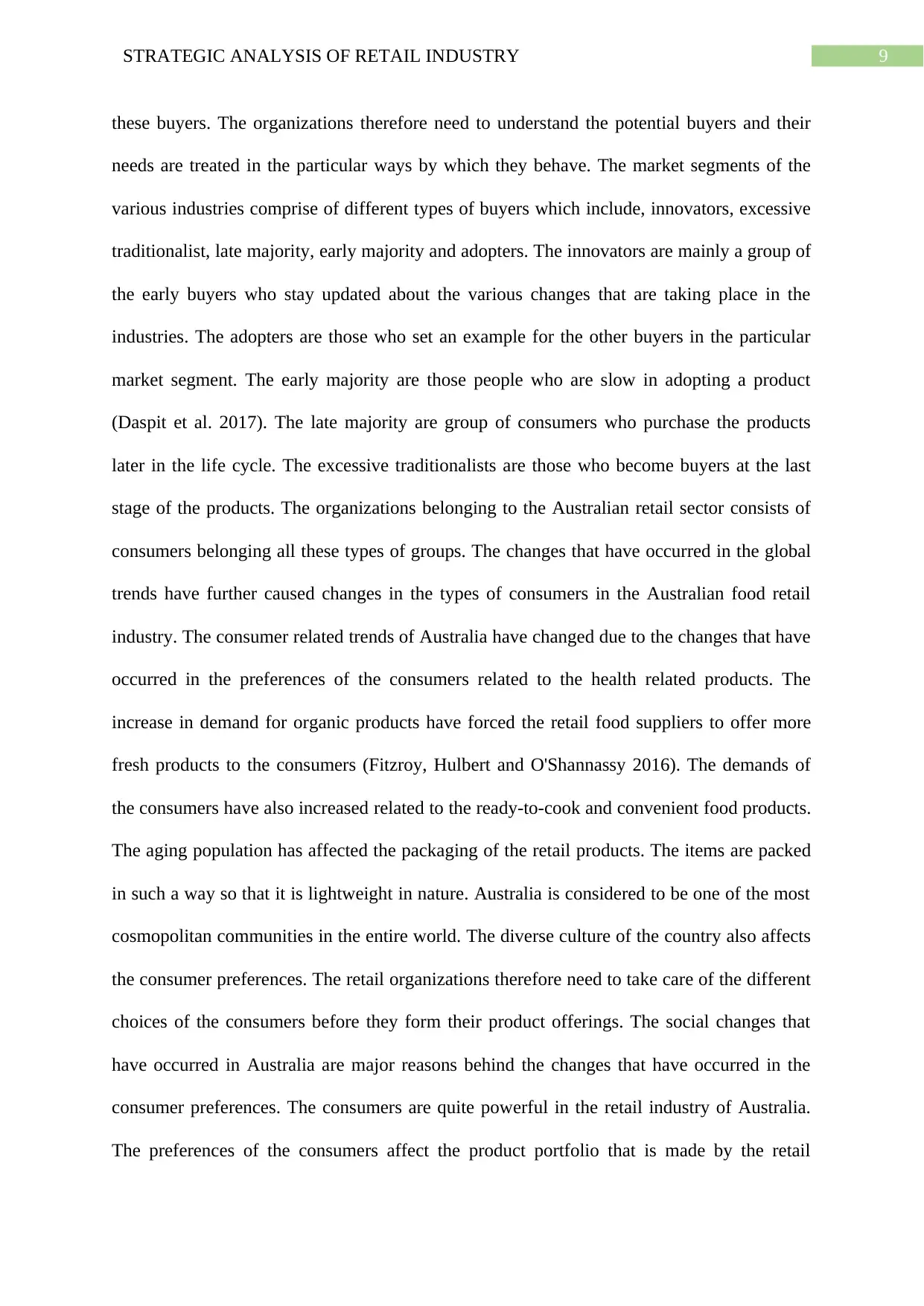
9STRATEGIC ANALYSIS OF RETAIL INDUSTRY
these buyers. The organizations therefore need to understand the potential buyers and their
needs are treated in the particular ways by which they behave. The market segments of the
various industries comprise of different types of buyers which include, innovators, excessive
traditionalist, late majority, early majority and adopters. The innovators are mainly a group of
the early buyers who stay updated about the various changes that are taking place in the
industries. The adopters are those who set an example for the other buyers in the particular
market segment. The early majority are those people who are slow in adopting a product
(Daspit et al. 2017). The late majority are group of consumers who purchase the products
later in the life cycle. The excessive traditionalists are those who become buyers at the last
stage of the products. The organizations belonging to the Australian retail sector consists of
consumers belonging all these types of groups. The changes that have occurred in the global
trends have further caused changes in the types of consumers in the Australian food retail
industry. The consumer related trends of Australia have changed due to the changes that have
occurred in the preferences of the consumers related to the health related products. The
increase in demand for organic products have forced the retail food suppliers to offer more
fresh products to the consumers (Fitzroy, Hulbert and O'Shannassy 2016). The demands of
the consumers have also increased related to the ready-to-cook and convenient food products.
The aging population has affected the packaging of the retail products. The items are packed
in such a way so that it is lightweight in nature. Australia is considered to be one of the most
cosmopolitan communities in the entire world. The diverse culture of the country also affects
the consumer preferences. The retail organizations therefore need to take care of the different
choices of the consumers before they form their product offerings. The social changes that
have occurred in Australia are major reasons behind the changes that have occurred in the
consumer preferences. The consumers are quite powerful in the retail industry of Australia.
The preferences of the consumers affect the product portfolio that is made by the retail
these buyers. The organizations therefore need to understand the potential buyers and their
needs are treated in the particular ways by which they behave. The market segments of the
various industries comprise of different types of buyers which include, innovators, excessive
traditionalist, late majority, early majority and adopters. The innovators are mainly a group of
the early buyers who stay updated about the various changes that are taking place in the
industries. The adopters are those who set an example for the other buyers in the particular
market segment. The early majority are those people who are slow in adopting a product
(Daspit et al. 2017). The late majority are group of consumers who purchase the products
later in the life cycle. The excessive traditionalists are those who become buyers at the last
stage of the products. The organizations belonging to the Australian retail sector consists of
consumers belonging all these types of groups. The changes that have occurred in the global
trends have further caused changes in the types of consumers in the Australian food retail
industry. The consumer related trends of Australia have changed due to the changes that have
occurred in the preferences of the consumers related to the health related products. The
increase in demand for organic products have forced the retail food suppliers to offer more
fresh products to the consumers (Fitzroy, Hulbert and O'Shannassy 2016). The demands of
the consumers have also increased related to the ready-to-cook and convenient food products.
The aging population has affected the packaging of the retail products. The items are packed
in such a way so that it is lightweight in nature. Australia is considered to be one of the most
cosmopolitan communities in the entire world. The diverse culture of the country also affects
the consumer preferences. The retail organizations therefore need to take care of the different
choices of the consumers before they form their product offerings. The social changes that
have occurred in Australia are major reasons behind the changes that have occurred in the
consumer preferences. The consumers are quite powerful in the retail industry of Australia.
The preferences of the consumers affect the product portfolio that is made by the retail
Paraphrase This Document
Need a fresh take? Get an instant paraphrase of this document with our AI Paraphraser

10STRATEGIC ANALYSIS OF RETAIL INDUSTRY
organizations in Australia. The bargaining power of the buyers in Australia are therefore high
and the retail organizations need to take care of this factor before formulating strategies
(Helfat and Martin 2015).
Threats related to the new entrants – The new entrants in the Australian retail
sector have been increasing since the last few years. The new organizations further
innovation in the retail industry. The innovative and new ways bring many changes in the
retail sector of Australia which include, strategy related to lower pricing, reduction of the
costs and providing the new value propositions to consumers. The companies in this industry
further need to formulate strategies to face the competition that is related to the products and
services that they offer. The organizations need to build barriers so that they can guard the
competitive edge over the other organizations. The retail organizations in the Australian
industry need to further increase their operations by building more capacities and investing in
the research and development related activities (Hill, Jones and Schilling 2014). This will be
helpful for the companies to maintain their positions in the industry in an effective manner.
The threats of new entries in the market is high as the economy of Australia has shown huge
growth in the recent times which has further attracted more organizations towards the retail
sector of the country. The booming economy of the country has therefore been able to
increase the levels of competition in the Australian retail market. The retail sector of the
country is dynamic in nature and this has been able to accommodate many new organizations
in the country. The retail organizations therefore have to be alert so that they are able to face
the threats whenever a new player enters the market (Jarzabkowski and Kaplan 2015).
Threats related to substitutes – The Australian retail industry has many huge
organizations like, Aldi, Big W, Bunnings Warehouse, Chemist Warehouse, Cotton On, Dan
Murphy’s, David Jones, EB Games, Harvey Norman, Ikea, JB Hi Fi, Kmart Australia, Myer,
Officeworks, Spotlight, Supercheap Auto, Target, The Good Guys, Toys ‘R’ Us and
organizations in Australia. The bargaining power of the buyers in Australia are therefore high
and the retail organizations need to take care of this factor before formulating strategies
(Helfat and Martin 2015).
Threats related to the new entrants – The new entrants in the Australian retail
sector have been increasing since the last few years. The new organizations further
innovation in the retail industry. The innovative and new ways bring many changes in the
retail sector of Australia which include, strategy related to lower pricing, reduction of the
costs and providing the new value propositions to consumers. The companies in this industry
further need to formulate strategies to face the competition that is related to the products and
services that they offer. The organizations need to build barriers so that they can guard the
competitive edge over the other organizations. The retail organizations in the Australian
industry need to further increase their operations by building more capacities and investing in
the research and development related activities (Hill, Jones and Schilling 2014). This will be
helpful for the companies to maintain their positions in the industry in an effective manner.
The threats of new entries in the market is high as the economy of Australia has shown huge
growth in the recent times which has further attracted more organizations towards the retail
sector of the country. The booming economy of the country has therefore been able to
increase the levels of competition in the Australian retail market. The retail sector of the
country is dynamic in nature and this has been able to accommodate many new organizations
in the country. The retail organizations therefore have to be alert so that they are able to face
the threats whenever a new player enters the market (Jarzabkowski and Kaplan 2015).
Threats related to substitutes – The Australian retail industry has many huge
organizations like, Aldi, Big W, Bunnings Warehouse, Chemist Warehouse, Cotton On, Dan
Murphy’s, David Jones, EB Games, Harvey Norman, Ikea, JB Hi Fi, Kmart Australia, Myer,
Officeworks, Spotlight, Supercheap Auto, Target, The Good Guys, Toys ‘R’ Us and
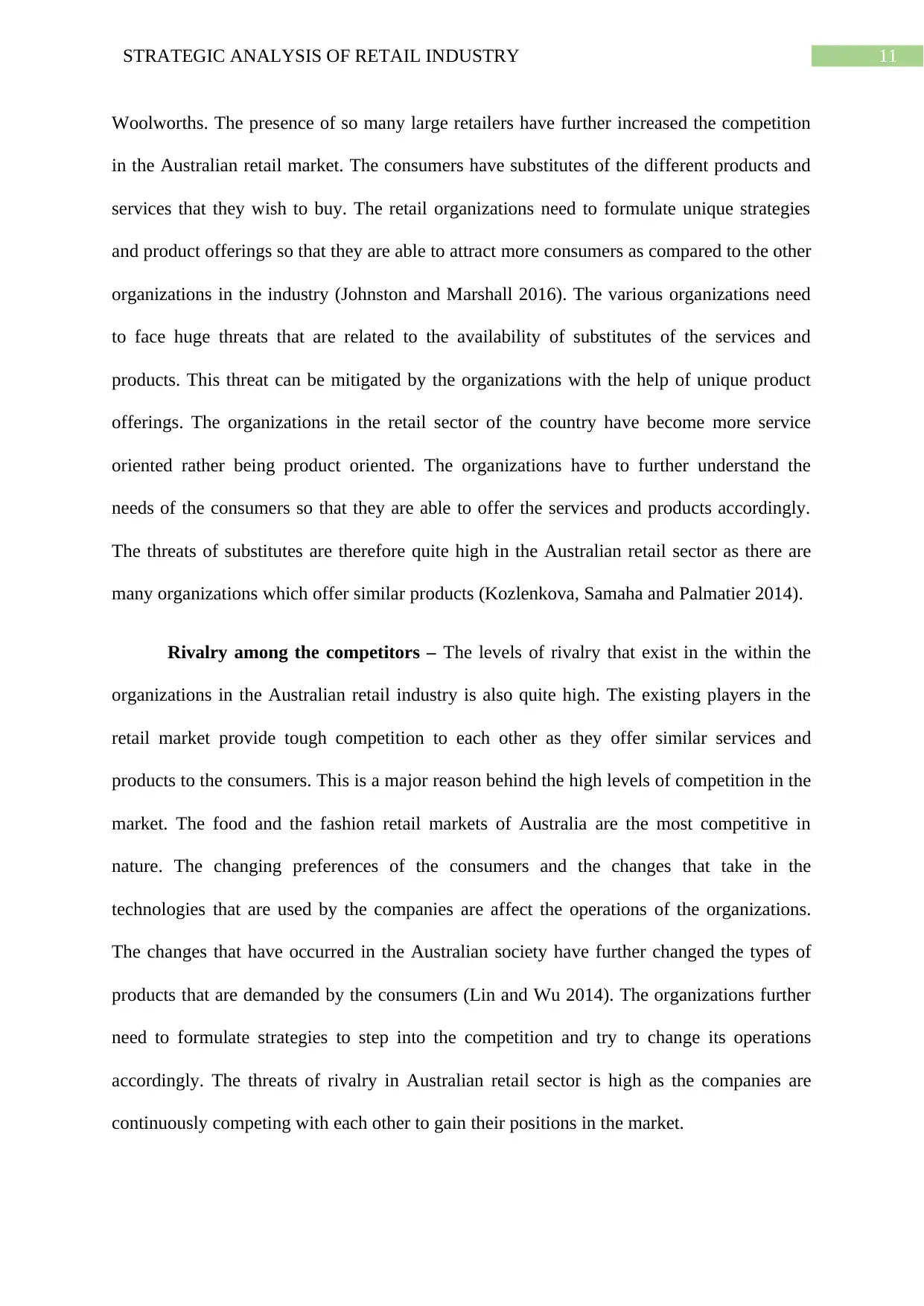
11STRATEGIC ANALYSIS OF RETAIL INDUSTRY
Woolworths. The presence of so many large retailers have further increased the competition
in the Australian retail market. The consumers have substitutes of the different products and
services that they wish to buy. The retail organizations need to formulate unique strategies
and product offerings so that they are able to attract more consumers as compared to the other
organizations in the industry (Johnston and Marshall 2016). The various organizations need
to face huge threats that are related to the availability of substitutes of the services and
products. This threat can be mitigated by the organizations with the help of unique product
offerings. The organizations in the retail sector of the country have become more service
oriented rather being product oriented. The organizations have to further understand the
needs of the consumers so that they are able to offer the services and products accordingly.
The threats of substitutes are therefore quite high in the Australian retail sector as there are
many organizations which offer similar products (Kozlenkova, Samaha and Palmatier 2014).
Rivalry among the competitors – The levels of rivalry that exist in the within the
organizations in the Australian retail industry is also quite high. The existing players in the
retail market provide tough competition to each other as they offer similar services and
products to the consumers. This is a major reason behind the high levels of competition in the
market. The food and the fashion retail markets of Australia are the most competitive in
nature. The changing preferences of the consumers and the changes that take in the
technologies that are used by the companies are affect the operations of the organizations.
The changes that have occurred in the Australian society have further changed the types of
products that are demanded by the consumers (Lin and Wu 2014). The organizations further
need to formulate strategies to step into the competition and try to change its operations
accordingly. The threats of rivalry in Australian retail sector is high as the companies are
continuously competing with each other to gain their positions in the market.
Woolworths. The presence of so many large retailers have further increased the competition
in the Australian retail market. The consumers have substitutes of the different products and
services that they wish to buy. The retail organizations need to formulate unique strategies
and product offerings so that they are able to attract more consumers as compared to the other
organizations in the industry (Johnston and Marshall 2016). The various organizations need
to face huge threats that are related to the availability of substitutes of the services and
products. This threat can be mitigated by the organizations with the help of unique product
offerings. The organizations in the retail sector of the country have become more service
oriented rather being product oriented. The organizations have to further understand the
needs of the consumers so that they are able to offer the services and products accordingly.
The threats of substitutes are therefore quite high in the Australian retail sector as there are
many organizations which offer similar products (Kozlenkova, Samaha and Palmatier 2014).
Rivalry among the competitors – The levels of rivalry that exist in the within the
organizations in the Australian retail industry is also quite high. The existing players in the
retail market provide tough competition to each other as they offer similar services and
products to the consumers. This is a major reason behind the high levels of competition in the
market. The food and the fashion retail markets of Australia are the most competitive in
nature. The changing preferences of the consumers and the changes that take in the
technologies that are used by the companies are affect the operations of the organizations.
The changes that have occurred in the Australian society have further changed the types of
products that are demanded by the consumers (Lin and Wu 2014). The organizations further
need to formulate strategies to step into the competition and try to change its operations
accordingly. The threats of rivalry in Australian retail sector is high as the companies are
continuously competing with each other to gain their positions in the market.
⊘ This is a preview!⊘
Do you want full access?
Subscribe today to unlock all pages.

Trusted by 1+ million students worldwide
1 out of 19
Related Documents
Your All-in-One AI-Powered Toolkit for Academic Success.
+13062052269
info@desklib.com
Available 24*7 on WhatsApp / Email
![[object Object]](/_next/static/media/star-bottom.7253800d.svg)
Unlock your academic potential
Copyright © 2020–2025 A2Z Services. All Rights Reserved. Developed and managed by ZUCOL.




